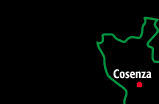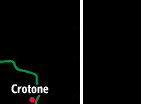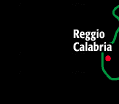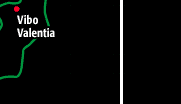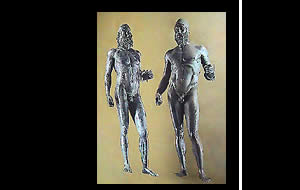|
Calabria Region
Although the toe of the Italian boot, enclosed
between two seas, may seem shaggy and wild, it offers countless
marvellous views: verdant and shady mountains, emerald green
sea, vast stretches of olive groves and vineyards dating
far back in history, and a mild climate that Franco Costabile,
the poet, describes as “warm as milk”.
Calabria was the birthplace of Mattia Preti, the great seventeenth-century
Italian painter: some of his wonderful paintings can still
be seen in his hometown, Taverna, splendidly situated amid
the woods at the foot of the Sila mountains, in the church
of Saint Dominic, in the Town Museum and in the church
di Santa Barbara. In Calabria, not only art, but culture of
every kind has very ancient roots. Pythagoras, the philosopher
and mathematician, had his school in Crotone, a powerful
and flourishing town of Magna Graecia, near Capo
Colonna where the lonely ruins of the Doric temple of Hera (Juno)
Lacinia stand. The area is famous for its lovely red beaches,
such as the one on Capo Rizzuto island; here, in the Le
Castella district, the Aragonese castle standing on a small island
can be seen in all its splendour: with its impressive bulk,
it seems to be defending the whole town, like a fearless
sovereign. More history can be felt in Locri, an ancient
Greek colony, in Gerace with its fascinating Cathedral and
in Byzantine Stilo.
A place rich not only in history but also in spirituality
is Serra San Bruno, built as a monastery founded in the Middle
Ages by Brunone di Colonia among the woods donated by Roger
the Norman.
Above all, Calabria has a wonderful coast. Pizzo is a lively
seaside town famous for the tartufo (truffle), a delicious
homemade ice cream. The old part of the town is full of narrow
streets, small flights of stone steps, archways and passages,
from where the blue sea can be glimpsed; on a bare rock stands
Castello Murat, where Napoleon’s brother-in-law, who
had arrived from Corsica in an attempt to win back the Kingdom
of Naples, was shot on 13 October 1815. Not far from Pizzo
are the wonderful beaches of Capo Vaticano, with a view stretching
to the Aeolian Islands, and Tropea, the hometown of Raf
Vallone,
with its picturesque piazza Ercole, many small squares, a
maze of small alleys, the brilliant Norman Cathedral, beautiful
churches including the Renaissance Michelizia and, on a small
tuff promontory, the church of S. Mary of the Island; Tropea
stands on a cliff overlooking the deep blue sea: it is delightful
to explore the little streets of the old town and discover
ancient doorways. Another very charming place is Scilla,
sung by Homer, standing on a crag overhanging the sea and
dominated by the mythical rock of the Castle of the Ruffo
family; the beautiful cove of Marina Grande and the charming
Chianalea district, with fishermen’s boats on the beaches,
are rich in colours, scents and atmosphere.
In addition to its coast, Calabria has really unique hill
and mountain scenery. The scenery in the Sila mountains,
with so many rivers, lakes and forests, is wonderful and
there are well-known tourist resorts like Camigliatello and
Lorica. And nobody can fail to be impressed by the Aspromonte,
a mountain with many contrasts, where green woodlands and
yellow broom alternate with fertile plains, sunny clearings
and rushing torrents.
Cosenza is a city with noble cultural traditions and a walk
through the old town is extremely interesting: artistic life
centres around the Rendano Theatre. But the feather in the
Region’s cap is certainly Reggio Calabria and its magnificent
seafront, with its palms and tall magnolia trees: there is
a breathtaking view of the Strait of Messina, especially
at night when the lights are sparkling, and you feel that
you could reach out and touch the Sicilian coastline. Reggio
has many buildings in classical and late Art Nouveau style
but the most important part of its history can be found in
the treasures of the National Museum, which houses the two
wonderful Bronze Statues from the 4th century B.C., discovered
in the sea at Riace in 1972. These two splendid warriors,
2 metres high, are exceptional for the wonderful sculptural
lines of their bodies and the expressiveness of their faces:
you can look at them for hours because they are an expression
of Greek art at its height.
For more information click on:
Calabria Region  ENTER ENTER |



 Notice
Notice
|













